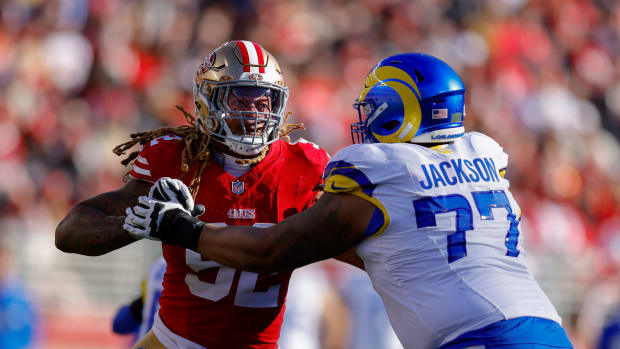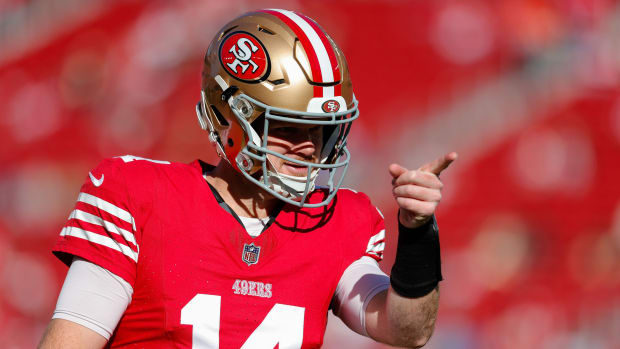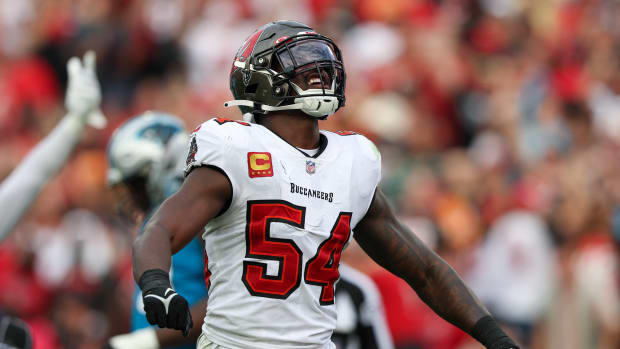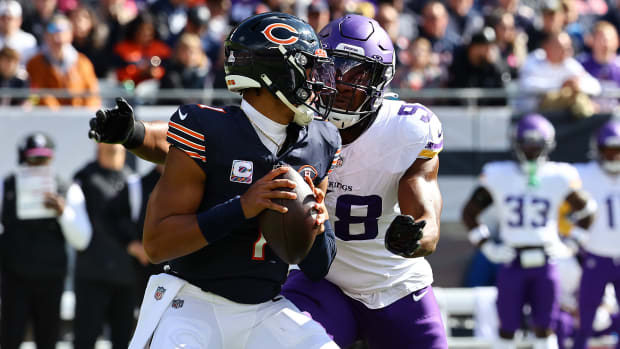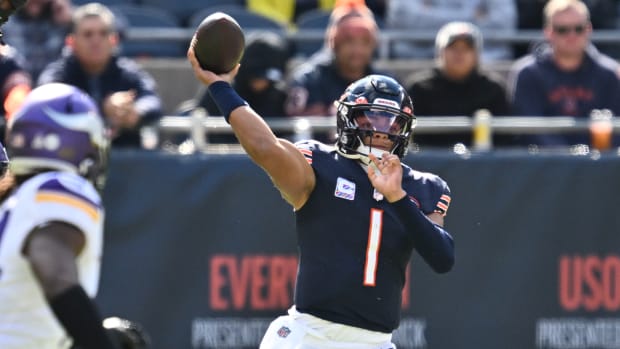For Rams Hero Mike Jones, Every Yard Is Hard-Fought
The MMQB is on the road to Super Bowl 50, telling stories of the game’s history and the Panthers-Broncos matchup, meeting notable Super Bowl figures and exploring what the game means to America, from coast to coast. Follow the journey on Twitter and Instagram (#SB50RoadTrip), as well as at The MMQB’s Facebook page, and check out our stories and video on our Road to Super Bowl 50 hub. And if you see us on the road, give a wave.
JEFFERSON CITY, Mo. — Mike Jones likes to impress upon his Lincoln University Blue Tigers football team the extraordinary work ethic of his former NFL teammates—guys like Marshall Faulk and London Fletcher—and the cohesiveness of those Rams teams that went to two Super Bowls, hoisted one Lombardi Trophy and was dubbed The Greatest Show on Turf.
But for some reason, The Tackle isn’t part of the coach’s history lesson.
“I was in elementary school when they won the Super Bowl,” says Treston Pulley, a senior linebacker from Sikeston, Mo., who arrived here in 2011, Jones’ first season on Lincoln’s sideline. “Coach talks to us about how they were the worst team in the league the year before, and they started taking ownership, holding player meetings, and things turned around.”
Yes, things turned around for the Rams after a 4-12 season in 1998. The emergence of Kurt Warner helped. But those Rams wouldn’t register on the Richter scale of Super Bowl lore if not for the defining play that changed Jones’ life: The Tackle. It was Jones, a 30-year-old undrafted linebacker in his ninth season, who made the game-saving tackle with six seconds remaining in Super Bowl XXXIV. He peeled off Titans tight end Frank Wycheck and arrived just in time to take down wide receiver Kevin Dyson at the 1-yard line to secure the Rams’ 23-16 victory.
“My dad figured it out who [Jones] was when we got to campus back in the summer of 2011,” Pulley says, “but that play is not really something coach talked about with us.”
At Division II Lincoln, in this bleak corner of Missouri’s capital city, Jones is too mired in the physical and psychological grind of smalltime college football to relive personal glories. While the world is celebrating the greatest moments in Super Bowl history, Jones is worried about securing the commitments of 18- and 19-year-olds in advance of Wednesday’s National Signing Day. Jones, who took over the program after winning a Missouri high school state championship, is 8-47 entering his sixth season. He chalks up the struggles to a flaw in his early recruiting strategy: straying too far from the principles he now stresses.
“It’s been a challenge,” Jones says from behind the desk in a decades-old home that was turned into a football office near the 5,500-seat stadium. “Put simply, we recruited the wrong kids whose emphasis wasn’t getting their college degree. And then we had to change that.”
Jones welcomed The MMQB to campus on Sunday at the tail end of a recruiting marathon. His assistant coaches were spread across the region ferrying recruits to the airports in Kansas City and St. Louis. He had been up at 2:30 that morning for an airport run, but still showed up early for our meeting, just before noon, in a bright red Dodge Charger and wearing a Lincoln button-up. In the coaches’ meeting room, recruiting target tallies filled the white boards and a bible rested on the conference table next to a glass chessboard.
Despite his hectic schedule, Jones can’t escape nostalgia at this time of year. There’s always someone who wants to talk about The Tackle, about Dyson, and about their shared place in Super Bowl history.
“I talked to Kevin last year,” Jones says. “We had a sit-down interview in Nashville at the high school where he’s the athletic director. They have a media department and we sat there and watched it on the big screen. Every other year we probably get together some way or another, and every year we talk on the phone about it. We’ll be connected for the rest of our lives.”
Contrary to popular assumption, their Super Bowl wasn’t decided by a whim—it was all part of the defensive assignment. Jones, who was originally covering Wycheck on the play, kept an eye on Dyson as he sprinted from the sideline to the center of the field. Though Jones had rolled an ankle when Titans fullback Lorenzo Neal thumped him earlier in the game, he still switched to cover Dyson, per his zone responsibilities.
“Kevin and I have talked about this,” Jones says. “I thought I was going to kill him, because he didn’t know I was coming—but Kevin actually knew that I was in that coverage. So I went from killing him to just trying to tackle him, and he hits the ground and sticks the ball out. It was a little too close for comfort.”
A decade after that season, Jones coached Hazelwood East High to a Missouri state championship, winning the 2008 title on a touchdown pass as time expired. He then coached the linebackers at Southern University in Baton Rouge, La., in 2010, before becoming a head coach in the college ranks. The following season he took over a very old and very stagnant football program at Lincoln, where they’ve played football since 1920 and haven’t had a winning season since ’72.
In Jones’ first season, 150 students came out for the football team. They finished the season with about 30 on the roster. “I think some guys at first didn’t take it very seriously,” says Eric Howard, a senior defensive tackle. “We conditioned a lot, and a lot of guys couldn’t hang with that, and many of them felt they were better than the team.”
When Jones arrived, he says the team GPA was 1.75, with a half dozen players on the honor roll. Now it’s 2.5, with 33 honor roll students. There are even five students who finished last semester with a 4.0. That’s impressive for a team on which nearly a fifth of the players are fathers and many recruits come from impoverished communities in the Midwest, Los Angeles and South Florida.
One such student, Gabriel Soto of East Los Angeles, was murdered in his hometown in 2013 when a gunman opened fire on him and a group of friends who were gathered in an open garage. This past December, more than two years later, police arrested three men in connection with the killing of the 22-year-old. Jones keeps a photo of Soto on his desk, and despite Soto’s never having played in a game, his number 33 is honored on a weekly basis—the players decide who gets to wear it during a week of practices and on game day. “As long as I’m here,” Jones says, “That’s how it will be. He was a special young man.”
“We’re a family now,” Howard says. “There’s a football family here now where there wasn’t one before.”
The young men are also starting to absorb the lessons of Jones’ Rams teams—and not just the ones learned in prime time. They held their first players-only meeting last summer.
“It took us three or four years to get to a point where guys are graduating,” Jones says. “Our enrollment is up 25 percent, so now there’s 25 percent more people, and if you’re not winning football games, you’re going to be held accountable. Whether they play football or not, they want to be part of something that wins. We understand that and we have got to get that done.”
• Question? Comment? Let us know at talkback@themmqb.com




































